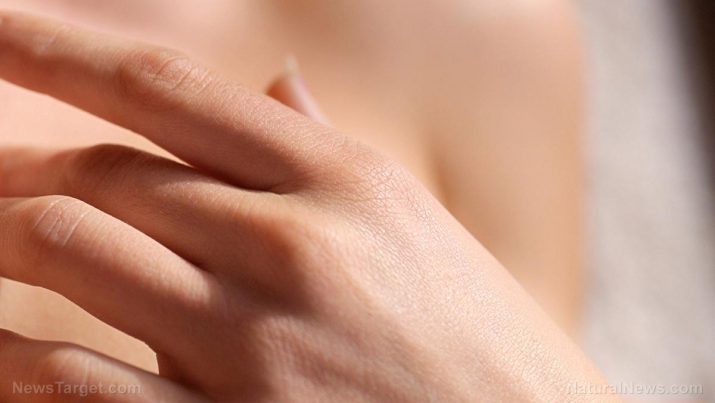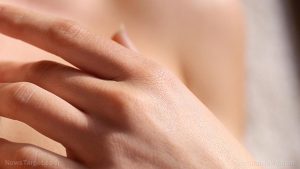
Keloids – causes, side effects and treatments at NaturalPedia.com
Friday, April 27, 2018 by Zoey Sky
http://www.naturalpedia.com/keloids-causes-side-effects-and-treatments-at-naturalpedia-com.html

Keloids, also known as keloid scars, are an abnormal type of wound healing. A keloid causes a large, soft growth where the skin was damaged. Despite their startling appearance, keloids are rarely harmful.
A keloid is an overgrowth of the scar tissue that develops around a wound and it often forms after the wound has healed. Keloids often spread beyond the original scar.
Keloids usually start to develop at least three months after the skin was originally damaged. However, in some cases keloids form after a year.
Keloid scars may continue to grow for several weeks to a few months. While the growth is often slow, sometimes there is rapid enlargement over a couple of months. When keloids stop growing they remain the same size or get smaller in time. When a keloid first starts forming, patients notice rubbery scar tissue that starts spreading beyond the borders of the original wound or injury.
In some cases, keloids develop without any obvious skin injury, but most individuals can pinpoint a specific cause.

Known side effects of keloids
The side effects of keloids usually include:
- A localized area in the skin that is flesh-colored, pink, or red
- A lumpy or ridged area of skin that’s often raised
- An area of skin that steadily grows larger due to scar tissue
- An itchy patch of skin
Both men and women have an equal chance of developing keloid scars. Risk factors for keloids may include:
- Being pregnant
- Being younger than 30
- Genetics — A person is more likely to have keloid scars if one or both of their parents had them.
- Race — Individuals with darkly pigmented skin, like African-Americans, are more prone to keloids. Asians and Latinos also have a high chance of developing keloid scars.
Body systems harmed by keloids
Keloids may cause the following complications:
- Cosmetic changes may affect the appearance of a person with a keloid. This complication often leads to people getting treatment.
- Irritation from the keloid rubbing on clothing or other forms of friction.
- Keloids may cause discomfort, pain, or tenderness.
- Keloids may limit mobility, especially if the scar was caused by burns or injuries. Keloid scars may also limit the mobility of body parts due to contractures of the skin and tissue.
- Patients may have difficulty moving if the keloid forms in areas like bends in the arms and legs or the joints.
- Very large or disfiguring keloids may cause psychological distress, e.g. when they affect the person emotionally.
Food items or nutrients that may prevent keloids
The following foods or nutrients can help prevent keloids or promote faster healing:
- Collagen — Collagen promotes faster tissue repair. Sources include vegetables like celery, cucumber, dark green vegetables (e.g. cabbage, kale, and spinach), and red fruits. Leafy greens also contain lutein, an antioxidant.
- Genistein — Soy contains genistein or plant hormones that are potent antioxidants. Sources include cheese, soy milk, and tofu.
- Hyaluronic acid — Hyaluronic acid is an anti-aging substance and beans can help the body produce more of this acid.
- Lycopene — Lycopene is nature’s sunblock. This antioxidant can also protect the skin from damage while also boosting collagen levels. Sources include beets, peppers, and tomatoes.
- Vitamins and supplements — Vitamins (e.g. vitamin E) and minerals can help wounds heal faster
Treatments, management plans for keloids
It can be difficult to treat keloids since the scarring is the body’s way of trying to repair itself. Even after removing keloids the scar tissue can grow back again. The new keloid may be even bigger than the first scar.
Keloid treatments may include:
- Corticosteroid injections — Can help reduce inflammation.
- Freezing the tissue — This kills skin cells.
- Laser treatments — May help reduce scar tissue.
- Moisturizing oils — Can keep the tissue soft.
- Pressure or silicone gel pads — Often used after injury.
- Radiation — Can shrink keloids.
- Surgery — Done to remove keloids.
Healthcare professionals will often recommend less-invasive treatments (e.g. silicone pads or injections) if the scarring is recent. These options usually require frequent and careful application to be effective. Do take note that keloids often shrink and become flatter in time, even without any treatment.
Larger keloids may need surgery. However, keloid scarring recurrence is high after surgery. Steroid injections after surgery can help lower the risk of the keloid returning.
Where to learn more
- 7 Effective Home Remedies to Get Rid of a Keloid
- 9 Best Home Remedies for Keloids & Scars
- 10 Amazing Benefits of Sandalwood Essential Oil for Health and Beauty
- Castor oil is great for thickening and regrowing hair, eyelashes and eyebrows
- Green tea nutrients found to successfully treat scars when used in a cream
Summary
A keloid, also known as a keloid scar, is an abnormal type of wound healing. A keloid causes a large, soft growth where the skin was damaged. Despite their startling appearance, keloids are rarely harmful.
The side effects of keloids usually include a localized area in the skin that is flesh-colored, pink, or red; a lumpy or ridged area of skin that’s often raised; an area of skin that steadily grows larger due to scar tissue; or an itchy patch of skin.
Keloids may cause complications like cosmetic changes that can affect the appearance of a person with a keloid; discomfort, pain, or tenderness due to the keloid; or irritation from the keloid rubbing on clothing or other forms of friction.
Collagen, genistein, hyaluronic acid, lycopene, or vitamins and supplements can help prevent keloids.
It can be difficult to treat keloids since the scarring is the body’s way of trying to repair itself. Even after removing keloids the scar tissue can grow back again. The new keloid may be even bigger than the first scar.
Keloid treatments may include corticosteroid injections, freezing the tissue, laser treatments, moisturizing oils, pressure or silicone gel pads, radiation, or surgery.
Sources include:
Tagged Under: Tags: keloid





